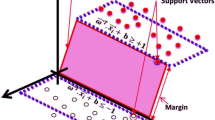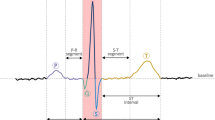Abstract
In this paper, we propose a novel ECG arrhythmia classification method using power spectral-based features and support vector machine (SVM) classifier. The method extracts electrocardiogram’s spectral and three timing interval features. Non-parametric power spectral density (PSD) estimation methods are used to extract spectral features. The proposed approach optimizes the relevant parameters of SVM classifier through an intelligent algorithm using particle swarm optimization (PSO). These parameters are: Gaussian radial basis function (GRBF) kernel parameter σ and C penalty parameter of SVM classifier. ECG records from the MIT-BIH arrhythmia database are selected as test data. It is observed that the proposed power spectral-based hybrid particle swarm optimization-support vector machine (SVMPSO) classification method offers significantly improved performance over the SVM which has constant and manually extracted parameter.
Similar content being viewed by others
References
Clifford G D, Azuaje F, McSharry P. Advanced Methods and Tools for ECG Data Analysis. Artech House London, 2006
Sandoe E, Sigurd B. Arrhythmia: A Guide to Clinical Electrocar Diology. Publishing Partners, 1991
Shyu L Y, Wu Y H, Hu W. Using wavelet transform and fuzzy neural network for VPC detection from the holter ECG. IEEE Transactions on Biomedical Engineering, 2004, 51(7): 1269–1273
Inan O T, Giovangrandi L, Kovacs G T. Robust neural-network-based classification of premature ventricular contractions using wavelet transform and timing interval features. IEEE Transactions on Biomedical Engineering, 2006, 53(12): 2507–2515
Ebrahimzadeh A, Khazaee A. Detection of premature ventricular contractions using MLP neural networks: a comparative study. Measurement, 2010, 43(1): 103–112
Zadeh A E, Khazaee A. High efficient system for automatic classification of the electrocardiogram beats. Annals of Biomedical Engineering, 2011, 39(3): 996–1011
Ince T, Kiranyaz S, Gabbouj M. A generic and robust system for automated patient-specific classification of ECG signals. IEEE Transactions on Biomedical Engineering, 2009, 56(5): 1415–1426
Khazaee A, Ebrahimzadeh A. Heart arrhythmia detection using support vector machines. Intelligent Automation & Soft Computing, 2013, 19(1): 1–9
Lin C H. Frequency-domain features for ECG beat discrimination using grey relational analysis-based classifier. Computers & Mathematics with Applications, 2008, 55(4): 680–690
Zeraatkar E, Kermani S, Mehridehnavi A, Aminzadeh A, Zeraatkar E, Sanei H. Arrhythmia detection based on morphological and timefrequency features of t-wave in electrocardiogram. Journal of Medical Signals and Sensors, 2011, 1(2): 99–106
Kaur M, Arora A. Classification of ECG signals using LDA with factor analysis method as feature reduction technique. Journal of Medical Engineering & Technology, 2012, 36(8): 411–420
Derya Übeyli E. Recurrent neural networks employing lyapunov exponents for analysis of ECG signals. Expert Systems with Applications, 2010, 37(2): 1192–1199
De Chazal P, O’Dwyer M, Reilly R B. Automatic classification of heartbeats using ECG morphology and heartbeat interval features. IEEE Transactions on Biomedical Engineering, 2004, 51(7): 1196–1206
Ye C, Bhagavatula V, Coimbra M. Heartbeat classification using morphological and dynamic features of ECG signals. IEEE Transactions on Biomedical Engineering, 2004, 59(10): 2930–2941
Llamedo M, Martnez J P. Án automatic patient-adapted ECG heartbeat classifier allowing expert assistance. IEEE Transactions on Biomedical Engineering, 2012, 59(8): 2312–2320
Andreão R V, Dorizzi B, Boudy J. ECG signal analysis through hidden markov models. IEEE Transactions on Biomedical Engineering, 2006, 53(8): 1541–1549
Martis R J, Chakraborty C, Ray A K. A two-stage mechanism for registration and classification of ECG using gaussian mixture model. Pattern Recognition, 2009, 42(11): 2979–2988
Mitra S, Mitra M, Chaudhuri B B. A rough-set-based inference engine for ECG classification. IEEE Transactions on Instrumentation and Measurement, 2006, 55(6): 2198–2206
Chazal d P, Reilly R B. A patient-adapting heartbeat classifier using ECG morphology and heartbeat interval features. IEEE Transactions on Biomedical Engineering, 2006, 53(12): 2535–2543
Osowski S, Markiewicz T, Hoai L T. Recognition and classification system of arrhythmia using ensemble of neural networks. Measurement, 2008, 41(6): 610–617
Vapnik V N. Statistical Learning Theory. Wiley, 1998
Vaseghi S V. Advanced Digital Signal Processing and Noise Reduction. Wiley, 2008
Welch P. The use of fast fourier transform for the estimation of power spectra: a method based on time averaging over short, modified periodograms. IEEE Transactions on Audio and Electroacoustics, 1967, 15(2): 70–73
Percival D, Walden A. Spectral Analysis for Physical Applications: Multitaper and Conventional Univariate Techniques. New York: Cambridge University Press, 1993
Burges C J. A tutorial on support vector machines for pattern recognition. Data Mining and Knowledge Discovery, 1998, 2(2): 121–167
Cortes C, Vapnik V. Support-vector networks. Machine Learning, 1995, 20(3): 273–297
Muller K R, Mika S, Ratsch G, Tsuda K, Scholkopf B. An introduction to kernel-based learning algorithms. IEEE Transactions on Neural Networks, 2001, 12(2): 181–201
Eberhart R, Kennedy J. A new optimizer using particle swarm theory. In: Proceedings of the 6th International Symposium on Micro Machine and Human Science. 1995, 39–43
Shi Y, Eberhart R C. Empirical study of particle swarm optimization. In: Proceedings of the 1999 Congress on Evolutionary Computation. 1999, 1945–1950
Moody G B, Mark R G. MIT-BIH arrhythmia database, http://ecg.mit.edu/dbinfo.html
Moody G B, Mark R G. The impact of the mit-bih arrhythmia database. IEEE Engineering in Medicine and Biology Magazine, 2001, 20(3): 45–50
Specht D F. Probabilistic neural networks. Neural Networks, 1990, 3(1): 109–118
Luan F, Zhang X, Zhang H, Zhang R, Liu M, Hu Z, Fan B. QSPR study of permeability coefficients through low-density polyethylene based on radial basis function neural networks and the heuristic method. Computational materials science, 2006, 37(4): 454–461
Rumelhart D E, McClelland J L. Parallel Distributed Processing: Ex plorations in the Microstructure of Cognition. MIT Press, 1986
Riedmiller M, Braun H. A direct adaptive method for faster backpropagation learning: the RPROP algorithm. In: Proceedings of the 1993 IEEE International Conference on Neural Networks. 1993, 586–591
Hagan MT, Menhaj MB. Training feedforward networks with the marquardt algorithm. IEEE Transactions on Neural Networks, 1994, 5(6): 989–993
Author information
Authors and Affiliations
Corresponding author
Additional information
Ali Khazaee received the BS degree in Electronic Engineering from the Ferdowsi University, Mashhad, Iran, in 2007 and MS degree from the Babol University of Technology, Babol, Iran, in 2009. Currently, he is pursuing the PhD degree in the Department of Communication, Babol University of Technology, Babol, Iran. His research interests include biomedical signal processing and pattern recognition.
Ataollah Ebrahimzadeh received the PhD degree in Electrical and Computer Engineering. He is now an Associate Professor in the Faculty of Electrical and Computer Engineering, Babol University of Technology, Babol, Iran. His current research interests include signal processing and artificial intelligence.
Rights and permissions
About this article
Cite this article
Khazaee, A., Zadeh, A.E. ECG beat classification using particle swarm optimization and support vector machine. Front. Comput. Sci. 8, 217–231 (2014). https://doi.org/10.1007/s11704-014-2398-1
Received:
Accepted:
Published:
Issue Date:
DOI: https://doi.org/10.1007/s11704-014-2398-1




